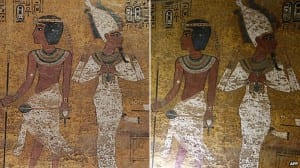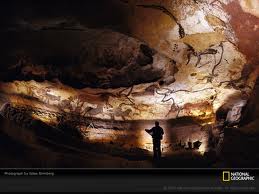The picture on the right is the original tomb, the one on the left is the replica.
King Tutenkamun’s tomb is being recreated. The copy will be next to Howard Carter’s house on the hill at the entrance to the Valley of the Kings. Initially tourists will be asked to choose which one to visit; the real or the fake. I wonder how many will make the journey to Egypt then opt to visit a replica of the most famous tomb in the world, when the real one remains open less than a mile away. The intention is to protect the original, damaged by the impact of tourism. It makes sense to appeal to the fragility of ancient burial sites, sealed up with the intention they would never be visited again, designed for darkness. It also raises questions about the difference between the real and the imitation.
In France the prehistoric cave paintings in Lascaux were discovered in 1940 and opened to the public in 1948. Visitor exposure created rapid air change. Body heat and breath were blamed for rapid growth of fungal mould threatening the 17000 year old pigments. The caves were closed within 15 years and the replica Lascaux II built nearby. Tourists can experience the colour, size and impact of the paintings without damaging the quality of the original.
What happens next? Maybe a tomb or cave for tourists to visit which isn’t a copy of an original but a synthesis passed off as authentic. Here is a way to alter history. A gradual seepage from the real to the artificial, in the name of preservation, with visitors no longer knowing the difference. Signs and simulations encourage us to feel we familiar with places and people we know nothing about. Consumers are saturated with media images of significance rather than substance, continually pressured to buy a product or engage in activity for what it represents rather than what it is. I think visiting a replica must be preferable to not having access at all. Education substantially depends on text and images which are facsimiles. I’d visit Lascaux II for the experience and probably not over-think the reconstruction. Soon I won’t even have to go to France because there are talks about Lascaux III which will go on tour.
I’ve stood in King Tut’s tomb and doubt the ability of any fake to replicate that sense of awe. Tut is a plain place. The tomb of Ramses VI is far more visually stunning. With Tut it’s the history which bestows the meaning. Knowing this is the place where the most fabulous of all Egyptian treasure was found. Authenticity like this can’t be duplicated but authentic experience is not sustainable if it risks destroying it. There are no easy answers; least of all what happens to the original? Preserved and protected, visited by a privileged few, secreted away behind locked doors and security systems. What price will be put on an original experience? Sounds like two-tier tourism in the making.

